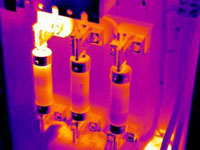Email : admin@astartesting.com.bd
INFRARED THERMOGRAPHY
IR Thermography is based on the concept that, the object which has absorbed heat or at some temperature value higher than the ambient or surrounding environment will emit infrared radiation (heat flux) at different wavelength. The IR thermography method uses a thermal image scanner or camera to record the heat flux which was emitted as infrared radiation. The thermal image describes the distribution of the surface temperature that will detect the defects in the subsurface of the material tested. Because of different thermal coefficients between the sample surface and the ambient, the heat will flow in different ways (thermal wavelength) and also at different rates and thus results in a different temperature distribution on the surface of the sample with respect to the defects in the tested material.
IR Thermography has two different approaches namely passive and active, depending on how thermal load is applied to the object to be tested.
In passive approach, test samples are naturally at a higher temperature than the ambient whereas in active approach, an external stimulus is necessary to apply thermal contrasts to the test material. In active thermography, test materials are to be heated above the ambient temperature. It can be applied in two methods, single sided and double-sided. In single-sided, the sample will be heated first and afterwards heat release will be recorded by the thermal image scanner, while in the case of double sided, thermal image scanner and heat source are placed on opposite sides with respect to the sample and the scanner is switched on simultaneously with the heat source.
In pulsed thermography method, the stimulation time will be less for higher thermal conductivity material and more for low thermal conductivity material. In this method initially the test material is heated and the thermal images are recorded during cooling cycle at regular intervals of time.
Applications:
Electrical Systems (faulty electrical or overloaded circuits)
Mechanical Equipment (abnormal warm motors and bearing failures)
Fluid Systems (line blockages, pipe or fluid temperatures, tank levels)
Building Applications (insulation defects, air infiltration, moisture defects)
Low-Slope Roofs (identify wet roof insulation)
 |
 |
 |
 |
||

